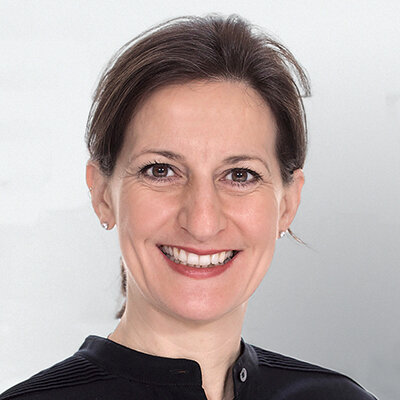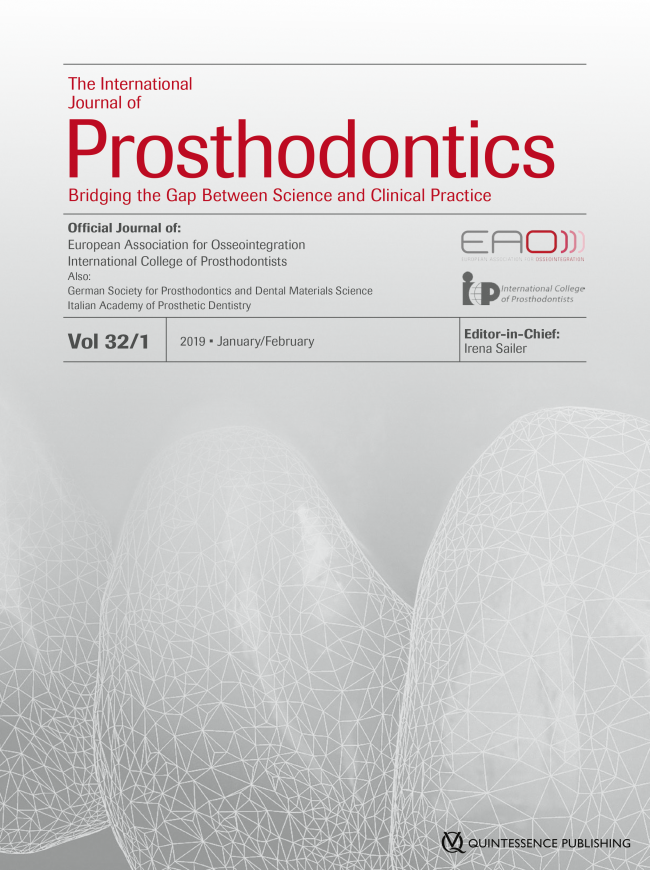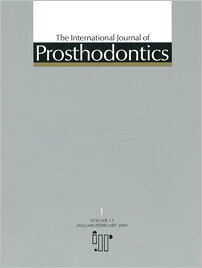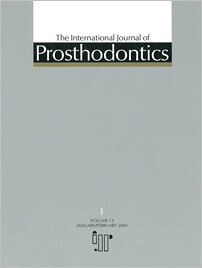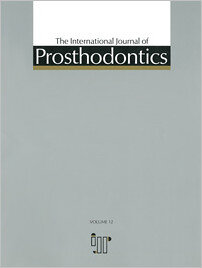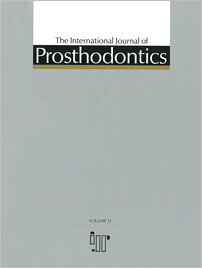Pages 189-193, Language: EnglishNakamura, Takashi / Nonaka, Masanori / Maruyama, TakaoPurpose: The purpose of this study was to evaluate the marginal and internal fit of alumina cores and all-ceramic crowns in a new preparation design for abutment teeth devised for copy milling.
Materials and Methods: Using conventional dies and dies from the new type of preparation design, 20 alumina cores were produced by copy milling, 10 cores in each die type. Also using the new type of die, another 10 final crowns were fabricated. Each of the 30 specimens was returned to its original die and embedded in epoxy resin. Each specimen was then sectioned labiolingually and measured for gaps at the margin, in the central area, and at the incisal edge.
Results: The alumina cores fabricated using the new type of die had mean gaps of 30 to 40 µm at the margins of the labial and lingual sides, which was significantly smaller than the gaps (67 to 130 µm) found in the alumina cores produced with the conventional type of die. The final crowns had mean gaps of 44 to 63 µm at the margins and on the inner surfaces. There was no significant difference in the gaps between the alumina cores produced using the new type of die and those found in the final crowns.
Conclusion: The new type of die was effective in allowing the fabrication of all-ceramic crowns that provide excellent marginal and internal fit by copy milling.
Pages 194-200, Language: EnglishMolin, Margareta K. / Karlsson, Stig L.Purpose: The present follow-up study aimed to evaluate the clinical quality and longevity of 3 ceramic inlay systems and compare them with gold inlays.
Materials and Methods: Twenty patients were treated with one Cerec, one Mirage, one Empress, and one gold inlay, respectively, inserted in a randomly selected order in the mandible. The inlays were examined independently by 2 calibrated examiners immediately after and 1, 3, and 5 years after luting. The inlays were rated using the California Dental Association (CDA) quality evaluation system.
Results: Two Empress inlays required replacement because of fracture between examination (Ex) 1 and Ex 2, and 2 Empress inlays were fractured between Ex 3 and Ex 4. One Cerec inlay had to be recemented after 3 months, and one Cerec inlay fractured between Ex 3 and Ex 4 and was replaced with a gold inlay. Examination showed that the mismatch of color increased from 15% to 50% between Ex 1 and Ex 4 for all ceramic systems. Visible evidence of ditching along the margin increased from 5% at Ex 1 to 70% at Ex 4, and an apparent discoloration of the margin between the tooth and the restoration was seen in 0% to 5% at Ex 1 compared to 30% to 55% at Ex 4.
Conclusion: Eight percent of the ceramic inlays were fractured during the follow-up period of 5 years. Based on the criteria of the CDA quality evaluation system, 92% of the 60 ceramic inlays and 100% of the 20 gold inlays were rated satisfactory 5 years after luting.
Pages 201-204, Language: EnglishCarossa, Stefano / Lojacono, Alessandra / Schierano, Gianmario / Pera, PaoloPurpose: The purpose of this study was to evaluate the influence of recording strip thickness and of operator-dependent factors on the assessment of contact area on a cast mounted on an articulator.
Materials and Methods: Thirteen dental students and 13 experts (dentists and dental technicians) performed occlusal maneuvers on casts mounted on an articulator, using recording strips of 8- and 40-µm thickness. Contact area, force, and time of biting relative to each group of operators using each type of paper were compared.
Results: Both groups obtained significantly greater contact areas with the thicker strip. Students applied significantly stronger but shorter bitings than experts, but obtained smaller contact areas, particularly with the thinner strip. In operators, the extension of contact markings using the 8-µm strip was closely related to the biting time but not to the occlusion force, while neither time nor force of biting had a significant influence when using the 40-µm strip.
Conclusion: The assessment of occlusal contact in the dental laboratory was significantly influenced by paper thickness, operator experience, biting force, and time. The 40-µm strip was less influenced by operator experience, strength, and duration of biting.
Pages 205-208, Language: EnglishTakahashi, Yutaka / Chai, John / Kawaguchi, MinoruPurpose: This study was undertaken to characterize the long-term equilibrium flexural strength at proportional limit (FSp) of 4 denture reline polymers processed onto 4 denture base polymers.
Materials and Methods: A 3-point flexural test was applied on rectangular specimens of each denture base polymer-denture reline polymer. Each specimen was immersed in water for 4 months prior to and 4 months after reline.
Results: Significant differences existed among the relined specimens because of the denture base polymer variable, the denture reline polymer variable, and their interaction (P 0.05). The descending order in FSp according to the denture base polymer, arranged in terms of statistical significance was: Acron ~ Acron MC > Triad > Palapress Vario, where ~ denotes no significant difference between Acron and Acron MC. The descending order in FSp according to the denture reline polymer, arranged in terms of statistical significance was: Triad > Rebaron > Rebaron LC > Tokuso Rebase. Significant difference existed among all of the denture reline polymers.
Conclusion: The present study showed that the long-term equilibrium strengths of 4 denture reline polymers processed onto 4 denture base polymers were different. The strength of the relined specimen of a denture base is dependent on the strength of the denture base polymer and that of the reline polymer.
Pages 209-213, Language: EnglishLoney, Robert W. / Price, Richard B. T. / Murphy, Darcy G.Purpose: Surface roughness can affect microbial colonization of long-term denture liners, alloys, and denture acrylic. The purpose of the present study was to examine the effect of finishing and polishing procedures on surface roughness of 4 temporary resilient denture liners (tissue conditioners).
Materials and Methods: Mean surface roughness was measured for 4 materials (Lynal, Visco-gel, Coe-Soft, and Functional Impression Tissue Toner [FITT]) finished in 4 ways: unfinished (control); polished; reduced, unpolished; and reduced, polished. Samples were allowed to polymerize at 37°C for 24 hours, and the surface roughness was measured using a Mitutoyo Surftest 212.
Results: Mean surface roughness ranged from 1.8 ± 0.8 µm for polished Lynal to 7.8 ± 1.1 µm for reduced, unpolished FITT. All polished samples were smoother than unpolished samples (including controls), whether or not the samples were reduced with a bur.
Conclusion: Polished samples of tissue conditioning material had lower mean surface roughness measurements than control or reduced, unpolished samples at the 95% level of confidence. There was no difference in mean surface roughness measurements of control samples and unpolished samples reduced with a bur at the 95% level of confidence. Mean surface roughness differed significantly between the materials tested.
Pages 214-220, Language: EnglishRagain, James C. / Grosko, Mark L. / Raj, Manisha / Ryan, Thomas N. / Johnston, William M.Purpose: This study compared surface detail parameters, interfacial contact angles, and die hardness for some combinations of elastomeric impression and die materials.
Materials and Methods: Representative polyvinyl siloxanes, polyether, polysulfide, and reversible hydrocolloid impression materials and Type IV, Type V, and resin reinforced-Type IV die materials were evaluated using a factorial design. For the evaluation of surface detail reproduction, the width of the thinnest continuous line observed and the visually observed shape of the thick line were determined from samples formed using a master die conforming to American Dental Association specification 19. The contact angle of freshly mixed die material on the set impression was measured using a contact angle goniometer. Finally, hardness of the die material was determined. After conversion of the data to ranks if necessary, 2-way analysis of variance with Ryan-Einot-Gabriel-Welsch (REGWQ) multiple comparison tests where appropriate were used to determine statistical significance.
Results: The thinnest continuous line demonstrated statistically significant impression material effects, and the observed shape of the thick line showed both statistically significant impression material and die material effects. For both contact angle and die hardness, a statistically significant interaction between the impression and die materials was found.
Conclusion: Although statistically significant differences in each property were found, no specific combination of impression and die materials was identified as superior to another for all surface properties studied.
Pages 221-226, Language: EnglishBlixt, Mariana / Adamczak, Ewa / Lindén, Lars-Åke / Odén, Agneta / Arvidson, KristinaPurpose: An important determinant of the clinical success of ceramic restorations is the bond strength of the luting agent to the seating surface and the prepared tooth structures. Manufacturers of ceramic systems frequently specify both the luting agent and preluting treatment of the seating surface of the crown. Procera AllCeram is an all-ceramic crown comprising a porcelain-veneered coping of densely sintered, high-purity aluminum oxide. This study evaluated the shear bond strength of 4 luting agents: zinc-phosphate, glassionomer, resin-modified glass-ionomer, and resin cement (dual cured) to Procera aluminum oxide coping material. The luting agents were subjected to different surface treatments: untreated, sandblasted, or silica coated by the Rocatec system.
Materials and Methods: Cylindric and cubic specimens of the coping material were luted together, and the shear force necessary to separate the cylinder from the cube was measured with a universal testing machine. The surfaces of the specimens were also analyzed.
Results: No significant differences were recorded for the shear bond strengths of the luting agents to the untreated aluminum oxide. Glass-ionomer and the resin-modified glass-ionomer cements had the highest values (4.2 ± 2.5 MPa and 4.3 ± 1.9 MPa, respectively), and the lowest were 3.3 ± 2.3 MPa for the resin cement and 3.2 ± 1.0 MPa for the zincphosphate cement. Similar results were recorded for the sandblasted aluminum oxide surfaces, except with the glass-ionomer, which was significantly higher (12.9 ± 2.4 MPa). For all 4 luting agents, the highest shear bond strength values were recorded for the silicacoated specimens; the highest was for the resin cement, at 36.2 ± 7.8 MPa.
Conclusion: The bond strengths between resin cement and aluminum oxide specimens treated by the Rocatec system were significantly higher than those of the other materials and surface treatments evaluated.
Pages 227-231, Language: EnglishHayakawa, Iwao / Hirano, Shigezo / Takahashi, Yasuki / Keh, En ShengPurpose: The purpose of this study was to examine changes in the masticatory function of complete denture wearers after relining the mandibular denture with a soft liner.
Materials and Methods: Conventional complete dentures were fabricated for 6 completely edentulous patients. One month after completing adjustments of the dentures, maximum biting force, masticatory performance, and electromyography of the masseter muscle during mastication were recorded. Chewing strokes, chewing time, muscular activity, and masticatory rhythm were calculated using the recorded electromyography. The mandibular dentures were then relined with a soft liner. One month after finishing adjustments of the relined dentures, the same tests were performed. These values were compared using a paired t test (a = 0.05).
Results: When using the soft liner, masticatory performance and maximum biting force were significantly greater (P = 0.019 and P = 0.023, respectively). In addition, the number of chewing strokes was significantly lower (P = 0.020), and chewing time was reduced (P = 0.010). A more stable masticatory rhythm was also found in the initial chewing stage. The muscular activity tended to decrease after the insertion of the lined denture, but no significant difference was found between before and after relining.
Conclusion: It was shown that applying a soft lining material to the mandibular dentures of 6 edentulous patients improved masticatory function with no adverse effect on the muscular task.
Pages 232-237, Language: EnglishSinclair, Gary F. / Radford, David R. / Sherriff, Martyn / Walter, John D.Purpose: The purpose of this study was to compare 3 different electrobrightening techniques and 3 electrolytic solutions in their effects upon the fit surface of cast cobaltchromium frameworks.
Materials and Methods: Fifty cast cobalt-chromium frameworks, which were subsequently divided into batches of 10, were prepared according to a standard protocol. Three electrobrightening techniques were tested initially using a single brand of electrolyte (Croform) and a batch of 10 frameworks per technique. The loss of metal by weight was determined from the fit surface of each casting. The least corrosive technique of these 3 was used again with 2 other brands of electrolyte (Nobilium and E501) in a repetition of the protocol. The fit surfaces of 8 random samples cut from each batch of electrobrightened castings were viewed by scanning electron microscope (SEM).
Results: Statistical analysis applying a one-way analysis of variance and Bonferroni's multiple comparison of means test demonstrated that one immersion of the framework for 10 minutes at 1 amp when used in conjunction with Nobilium electrolyte removed the least metal (P = 0.001). The SEM study suggested that the Nobilium electrolyte also produced the smoothest surface.
Conclusion: Electrobrightening techniques affect the amount of metal removed, and the electrolytic solution used influences the resultant surface.
Pages 238-245, Language: EnglishPayne, Alan G. T. / Solomons, Yvette F.Purpose: This article presents a critical review of the literature on the prosthodontic maintenance requirements of mandibular mucosa- and implant-supported overdentures.
Materials and Methods: A search of the literature produced 35 papers pertaining to prospective and retrospective studies. The relationship of these prosthodontic maintenance requirements to the axis of rotation treatment concept was examined.
Results: More often than not, 2 anterior mandibular implants either splinted (round or ovoid bars) or unsplinted (balls or magnets) have been used to evaluate this prosthodontic follow-up. Wide variation existed in the categories used for prosthodontic complications. Although principally related to alterations of overdenture contour and aspects of patrix and matrix maintenance, they also provide subjective information on relines and the rationale for avoiding overdenture fractures. These prosthodontic maintenance requirements undoubtedly have a direct impact on the time to retreatment of mandibular mucosa- and implant-supported overdentures.
Conclusion: There appears to be a need for a more uniform, standardized categorization with criteria for determining prosthodontic success, in terms of maintenance requirements and complications, for mandibular mucosa- and implant-supported overdentures. Controlled prospective evaluations of exact prosthodontic maintenance requirements of mandibular overdentures using different systems are lacking and encouraged. There is also an absence of prospective studies on such maintenance requirements of mandibular overdentures using multiple round bars on 3 or 4 implants.
Pages 246-253, Language: EnglishPayne, Alan G. T. / Solomons, Yvette F.Purpose: A prospective study on mandibular implant-supported overdentures using more than 2 Brånemark implants splinted with multiple round bars evaluated a hypothesis that unnecessary prosthodontic maintenance would result from the contravention of accepted biomechanical principles.
Materials and Methods: A randomized prospective trial on 59 edentulous patients details prosthodontic maintenance and complications of 52 mandibular overdentures (11 unsplinted, 41 splinted) over a 3-year period.
Results: Prosthodontic maintenance was greater in the first year than in subsequent years, regardless of design. Comparison between the splinted designs with round bars revealed no statistically significant difference with either retentive clip activation or fractures. More than 70% of the retention clips in the 2-implant (single round bar) design needed activation, as compared to 44% of those with the 3-implant (double round bar) or 4- implant (triple round bar) design. Retention clip fracture occurred in 30% of patients with 3 or 4 implants and 16% of those with 2 implants. Relining the overdentures, regardless of design, revealed an excessive maintenance burden in 40% of overdentures. Remaking of overdentures was necessary in 21% of patients.
Conclusion: Multiple round bars splinting 3 or 4 implants can still be a treatment concept in mandibular overdenture treatment. Results from prospective evaluation of this design indicate less prosthodontic maintenance of clip activation but more clip fractures than with 2 implants splinted with single round bars, although not at statistically significant levels.
